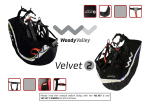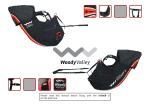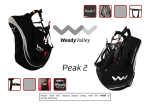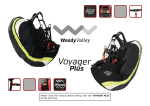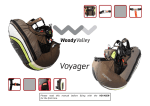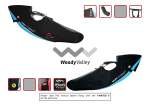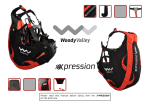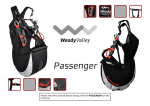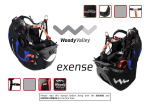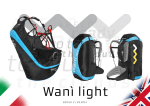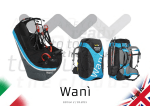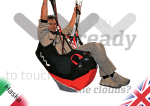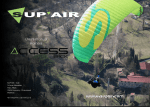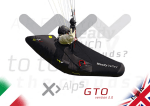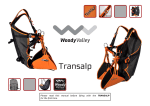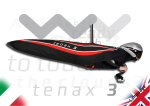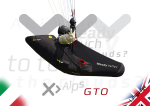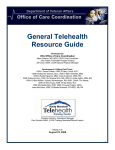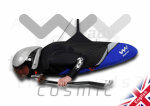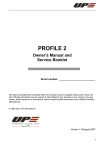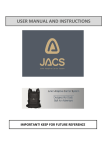Download Please read this manual before flying with the VELVET 2
Transcript
Please read this manual before flying with the VELVET 2 and VELVET 2 AIRBAG for the first time. THANK YOU! We would like to thank you for having chosen one of our products, and we invite you to read this important document, the User Manual for the harness. Please pay special attention to the two most important paragraphs, regarding: Insertion of the reserve parachute. The reserve parachute is a piece of equipment that may save your life. It must be treated so that it works correctly when it is required, whether this happens in two days’ time, or two years from now. Adjusting the harness. The harness forms the connection between the pilot and the paraglider, and it is an essential component in optimizing performance and the pleasure of flying. A bad harness that is well adjusted may enable you to fly well, but a good harness that is badly adjusted may put you off flying altogether. We are confident that this harness will give you greater comfort, control, performance and enjoyment in flight. We are conscious of the fact that reading an instruction manual is not an exciting experience. However, please remember that the respective product is not a citrus juicer or a mobile phone, and that correct use of the harness helps reduce the risk of flying accidents. This manual contains all the information necessary to assemble, adjust, fly and store your harness. Thorough knowledge of your equipment will improve your personal safety and your level of flying. The Woody Valley team SAFETY NOTE You have purchased a piece of equipment manufactured by us, and so you are aware of your identity as a paraglider pilot holding the respective pilot’s licence, and you accept all the risks connected to paragliding including the possibility of injury and death. The incorrect or inappropriate use of Woody Valley equipment greatly increases this risk. In no case can Woody Valley and the Woody Valley retailer be held responsible for personal injury caused to yourself or to third parties, or for whatever type of damage. If you have any doubts on the use of our equipment, please contact your retailer or the importer for your country. INDEX 1- GENERAL INFORMATION .................................................................................................................................................................................................................. 1 1.1- CONCEPT .................................................................................................................................................................................................................................................................................... 1 1.2- VELVET 2 PROTECTION............................................................................................................................................................................................................................................................. 2 1.3- VELVET 2 AIRBAG PROTECTION ............................................................................................................................................................................................................................................. 2 1.4- S.O.S. LABEL ............................................................................................................................................................................................................................................................................. 2 2- BEFORE USING THE HARNESS ......................................................................................................................................................................................................... 3 2.1- ASSEMBLING THE DORSAL PROTECTION FOR VELVET 2 ........................................................................................................................................................................................................... 3 2.2- RESERVE PARACHUTE ................................................................................................................................................................................................................................................................ 3 2.2.1- Connecting the deployment handle to the deployment bag ............................................................................................................................................................................. 4 2.2.2- Connecting the reserve parachute to the harness .............................................................................................................................................................................................. 4 2.2.3- Inserting the reserve parachute into the VELVET 2 harness ............................................................................................................................................................................ 7 2.2.4- Inserting the reserve parachute into the VELVET 2 AIRBAG harness ............................................................................................................................................................ 8 2.2.5- Reserve parachute deployment................................................................................................................................................................................................................................ 9 2.3- HARNESS ADJUSTMENTS ............................................................................................................................................................................................................................................................ 9 2.3.1- Body Control................................................................................................................................................................................................................................................................... 9 2.3.2- Adjusting the sitting position ..................................................................................................................................................................................................................................10 2.3.3- Back position adjustment.........................................................................................................................................................................................................................................10 2.3.4- Shoulder-strap adjustment .....................................................................................................................................................................................................................................11 2.3.5- Chest strap adjustment ............................................................................................................................................................................................................................................11 2.3.6- Leg strap adjustment ................................................................................................................................................................................................................................................12 3- FLYING WITH THE VELVET 2 AND VELVET 2 AIRBAG HARNESS .................................................................................................................................................... 12 3.1- PRE-FLIGHT CHECKS ................................................................................................................................................................................................................................................................ 12 3.2- POCKETS ..................................................................................................................................................................................................................................................................................13 3.3- DUAL FLYING ............................................................................................................................................................................................................................................................................13 3.4- FLYING ABOVE WATER ..............................................................................................................................................................................................................................................................13 3.5- TOW BRIDLE CONNECTION .........................................................................................................................................................................................................................................................14 3.6- LANDING WITH THE VELVET 2 AND VELVET 2 AIRBAG.......................................................................................................................................................................................................14 4- PACKING THE HARNESS ................................................................................................................................................................................................................. 14 5- FEATURES AND ASSEMBLY OF OPTIONAL ACCESSORIES ............................................................................................................................................................ 15 5.1- INSERTING SIDE PROTECTIONS (NO AIRBAG) .........................................................................................................................................................................................................................15 5.2- ASSEMBLY AND ADJUSTMENT OF THE SPEED-SYSTEM. ............................................................................................................................................................................................................15 5.3- COCKPIT AND FRONT BALLAST ASSEMBLY ................................................................................................................................................................................................................................ 16 5.4- RELAX-BAR ...............................................................................................................................................................................................................................................................................17 5.5- LEG COVER ...............................................................................................................................................................................................................................................................................17 5.6- POLYCARBONATE SEAT ............................................................................................................................................................................................................................................................17 6- MAINTENANCE AND REPAIR .......................................................................................................................................................................................................... 17 7- TECHNICAL DATA ........................................................................................................................................................................................................................... 18 8- CERTIFICATE OF APPROVAL .......................................................................................................................................................................................................... 19 8.1- VELVET 2 GET-UP CERTIFICATES ...................................................................................................................................................................................................................................19 8.2- VELVET 2 T-LOCK CERTIFICATES ....................................................................................................................................................................................................................................20 8.3- VELVET 2 AIBAG GET-UP CERTIFICATES .......................................................................................................................................................................................................................21 8.4- VELVET 2 AIRBAG T-LOCK CERTIFICATES.....................................................................................................................................................................................................................22 1- GENERAL INFORMATION The equipment supplied should comprise: -Harness -Wooden seat plate -Hook-in karabiners -Handle for reserve parachute deployment - 2 spare elastic loops for fastening the reserve parachute The optional extras comprise: - Speed-bar - Relax-bar - Front ballast pocket - Leg Cover (wind-proof cover) - Lightweight seat plate in polycarbonate - Side protections (NO AIRBAG) 1.1- Concept VELVET 2 is made in two versions, VELVET 2 (with foam protection) and VELVET 2 AIRBAG (with Airbag protection). VELVET 2 / VELVET 2 AIRBAG is a product that was developed wholly by Woody Valley to meet the demands specifically expressed by our pilots. This harness was created to be the ideal product for a large proportion of pilots, because we have dedicated special attention to comfort, while of course privileging safety. VELVET 2 / VELVET 2 AIRBAG is a simple, linear, lightweight harness, designed for maximum comfort and ease of use. It is easy to carry around when not in the air. 1 With this harness, chest-straps and leg-straps can be fitted with the “T-LOCK safety system” or with the “GET-UP safety system” to prevent the pilot from sliding out of the harness in the case that he or she has forgotten to fasten the leg-straps. 1.2- VELVET 2 protection VELVET 2 is fitted with dorsal protection in foam with a thickness of 17 cm. A sheet of high-density polyethylene on the outside of the foam dorsal protection provides a barrier in the case of collision with pointed objects, and the reinforced external fabric reduces the damage that could be caused to the harness by abrasion. This dorsal protection was designed to help the pilot in case of impact, reducing the energetic intensity of deceleration. However it cannot completely eliminate the risk of injury. 1.3- VELVET 2 AIRBAG protection The airbag provides excellent protection against the shock caused by impact. Its structure based on semi-rigid compartments ensures that about 60/70% of total protection is provided even without complete inflation, which occurs during the launch phase. When preparing for flight, before putting on the harness, check that the zip on the back is completely closed. In any case, the performance of the airbag underneath remains unchanged, because the opening between the airbag and the rucksack is of dimensions to ensure consistent results whether the zip is open or closed. When the zip is closed, the part of the airbag behind the back, corresponding to the large rear pocket, functions more effectively. When folding the harness, make sure that the padded section around the airbag inflation valve does not suffer any tight folds which could eventually mar its correct functioning. 1.4- S.O.S. label This label, coloured red with white lettering, is readily visible in a pocket on the right shoulder-strap padding. It is easy to pull out, and it is fastened to the harness to prevent it from being lost. On the back of this label, you can write the information that you think should be given to rescue personnel in case of accident. 2 2- BEFORE USING THE HARNESS VELVET 2 / VELVET 2 AIRBAG must be assembled by a qualified paragliding professional, such as your instructor. More specifically, great care has to be dedicated to inserting the reserve parachute into the harness in the correct way. Only after this has been performed should the pilot adjust the harness for maximum comfort. 2.1- Assembling the dorsal protection for VELVET 2 Woody Valley recommends that assembly should be performed in the sequence detailed below. In case of doubts or any other problems regarding this procedure, please consult your instructor, your Woody Valley retailer, or the importer. Normally the product is supplied with separate dorsal protection in foam and rigid plastic. This is rolled and packed separately. In this case, follow these steps for its installation: a. Remove the foam protection from its packaging (once it has been removed from its packaging, it may take about 2 hours to return to its normal shape) b. Open the zip on the side, below the Velcro protection on the bridle. Inside, you will find two pockets for the plastic protection. c. Insert the widest part of the rigid sheet into the lower pocket, so that the point fits into the upper pocket as shown in the illustrations below. Ensure that the oblique sides of the rigid protection follow the external stitching of the harness. d. Insert the foam protection as shown in the photographs. The foam will automatically fit into the correct position. Do not place the foam protection below the cross-buckles on the back of the harness. Should it be necessary to remove the protection, just extract it following the steps above in reverse order. 2.2- Reserve parachute The housing for the reserve parachute is below the seat in the front part of the harness. The container is large enough for most reserve parachutes on the market today. The reserve parachute has to be linked to the harness before it is inserted into the built-in pocket. This connection takes the form of a dual bridle fixed to the harness at shoulder height, for better load distribution and to ensure a correct landing position in the case that the reserve parachute is deployed. This helps 3 reduce the risk of injury to a minimum. The reserve chute bridle has a large central loop coloured red, and this is reinforced with a cover in Cordura 500. At the extremity of the loop, there is a Velcro band which enables the link with the reserve parachute to be held firmly in position. 2.2.1- Connecting the deployment handle to the deployment bag VELVET 2 / VELVET 2 AIRBAG is supplied with a handle for reserve parachute extraction. It is identified with the number 6; this handle alone should be used for this purpose. The black loop attached to the handle itself should be passed into the loop on the deployment bag, and then the entire handle should be passed through its own loop and pulled tight. For easier extraction, the loop attached to the deployment bag should be positioned laterally with respect to the centre of the reserve parachute. If your deployment bag does not have this loop, please contact the retailer from whom you purchased the reserve parachute. 2.2.2- Connecting the reserve parachute to the harness There are three different methods of attaching the reserve parachute bridle to the harness bridle. First system: Use a screw-lock karabiner with a breaking strength of at least 2,000 kg. In this case, the bridles should be held in position within the karabiner using elastic bands, to prevent the karabiner from rotating and taking the strain laterally instead of vertically. The karabiner’s screw-lock should be tightly screwed shut to avoid any possibility of it opening accidentally. This type of connection can absorb a higher opening shock than the second system, and for this reason this is without doubt the recommended system. 4 Second system: The reserve parachute bridle is passed through the loop at the end of the harness reserve parachute bridle. The reserve parachute itself is then passed through the large loop in the reserve parachute bridle. This connects the two bridles. The loops should be pulled as tight as possible to avoid any chance of dangerous friction developing between the two bridles during the shock caused when the reserve parachute opens. To ensure that the link between the two bridles remains tight, remember to fasten the knot using the Velcro strip on the harness reserve parachute bridle. Third system: If you are using a reserve parachute with directional control and dual bridle, or if your reserve parachute in any case has a double-riser bridle, it can be connected to the harness using the two loops positioned at the base of the harness bridle, near the padded shoulder straps. In this case, the harness’ reserve parachute bridle will not be used, and so it should be folded, fastened using two elastic bands, and positioned under the cover behind the pilot’s neck. 5 The two connections should be made using screw-lock karabiners with a breaking strength of at least 1,400 kg. In any case, it is important to verify that the length of the bridle is sufficient to position the reserve parachute inside the harness pocket, and that there is sufficient play to enable the parachute to be taken out of the pocket without causing the reserve parachute deployment bag itself to open during extraction. IMPORTANT: To prevent anomalous lateral loads, the bridle should be attached to both the loops on the shoulder straps. Not to just one of them. 6 2.2.3- Inserting the reserve parachute into the VELVET 2 harness Insert the reserve parachute into the pocket of the harness, so that the handle is visible and facing outwards, and the loop connecting the handle to the deployment bag is facing upwards. Thread a thin cord (such as paraglider riser cords) through each elastic loop. This will help close the pocket. Thread the elastic loops into the smallest of the eyelets on the pocket flaps. Close the flaps following the order shown in the photographs below. Push the metal pins on the handle into the elastic loops and under the transparent cover. It is essential to remove the cords after this operation. The cords should be pulled out slowly in order not to damage the elastic loops by excessive friction. Lastly, the handle should be positioned under the elastic cover. IMPORTANT: Every new combination of reserve parachute and harness or the external container assembled for the first time should be tested by an official harness or reserve parachute dealer, or by a flying instructor. Deployment of the reserve parachute should be perfectly feasible from the normal flying position. 7 2.2.4- Inserting the reserve parachute into the VELVET 2 AIRBAG harness Insert the reserve parachute into the pocket of the harness, so that the handle is visible and facing outwards, and the loop connecting the handle to the deployment bag is facing upwards. Thread a thin cord (such as paraglider riser cords) through each elastic loop. This will help close the pocket. Thread the elastic loops into the smallest of the eyelets on the pocket flaps. Close the flaps following the order shown in the photographs below. Push the metal pins on the handle into the elastic loops and under the transparent cover. It is essential to remove the cords after this operation. The cords should be pulled out slowly in order not to damage the elastic loops by excessive friction. Lastly, the handle should be positioned under the elastic cover. IMPORTANT: Every new combination of reserve parachute and harness or the external container assembled for the first time should be tested by an official harness or reserve parachute dealer, or by a flying instructor. Deployment of the reserve parachute should be perfectly feasible from the normal flying position. 8 2.2.5- Reserve parachute deployment It is vital to feel periodically for the position of the reserve parachute deployment handle during normal flight, so that the action of reaching for the reserve parachute handle becomes instinctive in an emergency. In emergency situations, the deployment procedure is as follows: Look for the reserve parachute handle and grasp it firmly with one hand. Pull the handle outwards in order to extract the reserve parachute from the harness container. Look for a clear area, and, in a continuous motion, throw the reserve parachute away from yourself and the paraglider. After the reserve parachute has opened, avoid entanglement by pulling in the paraglider, gripping at least one D line, or the brake lines, in order to collapse the glider. On landing, adopt an upright body position, and ensure that you perform a PLF (Parachute Landing Fall) to minimize the risk of injury. 2.3- Harness adjustments The VELVET 2 / VELVET 2 AIRBAG harness provides a number of methods of adjustment so that the pilot can fly in the ideal position. A little time has to be invested in finding the optimum position, but this effort will be rewarded by exceptional comfort in flight. Before making any adjustments, the reserve parachute must be in position. To find the best position, we suggest hanging in your harness from a suitable point of support, simulating flying position and conditions. For this reason, it is best to place all the things that you would normally carry with you when flying into the back pocket (rucksack, accessories, extra clothing and other sundry items). 2.3.1- Body Control The VELVET 2 / VELVET 2 AIRBAG harness is fitted with the new Body-Control system, which ensures that the pilot is closely connected to the harness. This offers an unprecedented sensitivity in piloting your paraglider. This type of sensitivity is very important in active flying techniques. 9 2.3.2- Adjusting the sitting position The first adjustment procedure regulates the angle between the thighs and the back (depth of seat). This angle can be varied from about 90° to 130°, by adjusting the straps running through the lateral trimmers. The lateral straps help you adjust the sitting angle, and they provide leg support on long flights. 2.3.3- Back position adjustment By adjusting the back (using the trimmers higher up on the side), the pilot adjusts the inclination of the torso with respect to the vertical axis in flight. A good flying position, improving control of the glider, is obtained by positioning the face at about 15 cm from an imaginary line between the two karabiners. 10 2.3.4- Shoulder-strap adjustment Adjustment of the shoulder pads compensates for the variation in pilot height and the adjustment buckle is located in front of the pilot's shoulder. The shoulder pads also bear part of the weight of the upper body for improved comfort. We recommend adjusting the shoulder pads so that they fit against your shoulders without being too slack or too tight. 2.3.5- Chest strap adjustment The chest strap adjusts the distance between the two karabiners, and it can be set between 37 and 48 centimetres. When the chest strap is tighter, stability is greater. We recommend a length of about 40-42 cm. A wider distance does not improve glider performance, and a smaller distance can accentuate the effects of a “twist” following an asymmetric collapse. 11 There is also a small elastic clip at the extremity of the padded shoulder-straps. This prevents the shoulders from slipping out of the straps during the launch run. The plastic clip also includes a useful whistle that can be used in emergency situations. 2.3.6- Leg strap adjustment Because the leg straps are attached relatively high up, the pilot has considerable freedom in thigh movement. Normally, the manufacturer’s original setting should be satisfactory. However it is important to try reaching the correct seated position in the launch phase without using your hands, by testing the movements in a flight simulator. If you cannot achieve the seated position without using your hands, the sitting angle has to be checked, and then the leg straps should be readjusted. IMPORTANT All adjustments have to be performed symmetrically on both sides. 3- FLYING WITH THE VELVET 2 AND VELVET 2 AIRBAG HARNESS 3.1- Pre-flight checks For maximum safety, use a complete and consistent system of pre-flight checks and repeat the same mental sequence every flight. Check that: • all buckles are fastened. Take particular care in the case of ice or snow. Always clean off snow or ice before fastening buckles; 12 • the reserve parachute handle is fastened in its correct position, and the pins are firmly inserted; • pockets and zips are closed; • the paraglider is connected correctly to the harness, and that both karabiners are locked closed by means of their locking system; • the speed bar is attached correctly to the glider. 3.2- Pockets The VELVET 2 / VELVET 2 AIRBAG harness has a large dorsal pocket and small pockets on each side, arranged so that contents cannot fall out during flight even if pockets are left open. These pockets are on the two sides of the harness, and they have a zip for closing them. 3.3- Dual flying The VELVET 2 harness can be used for dual flying, while the VELVET 2 AIRBAG harness is best not used for flying dual, because a passenger in front of the pilot would obstruct the inflation valve, preventing the airbag from reaching its optimum protective capacity. 3.4- Flying above water It is inadvisable to use the VELVET 2 / VELVET 2 AIRBAG harness on flights over water. In the event of the pilot being forced to land on the water, the foam dorsal protection or the airbag, which are filled with air, may force the harness into a position that holds the pilot underwater. Woody Valley recommends the use of a suitable lifejacket when flying over water. 13 3.5- Tow bridle connection The VELVET 2 / VELVET 2 AIRBAG harness can be used for towed launches. The tow bridle release should be hooked directly to the main karabiners, ensuring that the karabiners are positioned with the opening bar facing the rear. For further details, refer to the documentation provided with your tow release, or ask a qualified towing instructor at your flying site. 3.6- Landing with the VELVET 2 and VELVET 2 AIRBAG Before landing, slide your legs out and off the seat surface, so that you take up a standing position. Never land in the seated position; it is very dangerous for your back even if you have foam dorsal protection or an airbag, which provide exclusively passive protection. Standing up before landing is an active safety precaution, and it is much more effective than passive forms of protection. 4- PACKING THE HARNESS Packing the VELVET 2 harness is similar to the system used in general for all paraglider harnesses. The only difference is in the method of folding the semi-rigid “hood” section. This has to be performed as shown in the illustrations below, because otherwise, unwanted folds may appear that cannot be eliminated. 14 5- FEATURES AND ASSEMBLY OF OPTIONAL ACCESSORIES 5.1- Inserting side protections (NO AIRBAG) Put the side protections into the inside pockets located on the sides of the harness. To facilitate the insertion, lift the seat board for easy access to the space between the main webbing and the neoprene side pocket. Follow the steps shown below to complete insertion. 5.2- Assembly and adjustment of the speed-system. After having adjusted the sitting position to the optimum configuration, the accelerator must be adjusted. This harness is compatible with all normal types of speed-system accelerators. The elastic in front of the board holding the speed-bar prevents the reserve parachute handle from becoming entangled in the speed system during deployment of the reserve parachute. The speed-bar cords are threaded firstly through the eyes fixed to the elastic in front of the board, and then into the harness through the eyes near the front corners of the seat, after which they are led through the pulleys near the rear corners of the seat and brought directly up to connect to the paraglider risers. To adjust the system correctly, the pilot has to adopt a flying position in the harness, suspended from a flight simulator, and hook into the risers 15 of the paraglider. Another person then helps by supporting the risers, so the pilot can adjust the length of the speed-system cords. When no pressure is exerted on the speed bar, the bar must be at a distance no greater than 10 cm below the front of the harness. If the speed-bar cord is too short, it could cause a constant force on the bar during flight, so that the accelerator is unintentionally engaged at all times in flight. It is safest to take off with the speed-bar a little too long, progressively shortening it during the next flights. Remember that all adjustments have to be performed symmetrically, on both sides. 5.3- Cockpit and front ballast assembly On all our harnesses, a special front container can be fitted, complete with ballast, map case and instrument panel. The only exceptions are harnesses with a front-mounted reserve parachute, or in which the cockpit has been integrated into the structure of the harness itself. The “cockpit and front ballast container” is fixed using the webbing loops which are hooked into the main karabiners. The karabiners should be opened and passed through the red loops of the support strap, with the opening bar facing the rear. A webbing triangle is sewn to both sides of the container, with a fastening buckle that can also be used for adjustment. By modifying the position of the fastening buckle and the length of the strap, the height and inclination of the instrument panel can be varied as required. 16 5.4- Relax-bar A relax-bar can be fitted to all our harnesses, except for those already incorporating this accessory. The relax-bar is used to keep the legs stretched out and the feet resting on a support. Some pilots consider this flying position as more comfortable than the classic seated position with legs hanging. To attach the relax bar to the harness, follow the instructions provided in the relax-bar instruction manual. 5.5- Leg Cover Leg Cover is a product that has been developed uniquely by Woody Valley in order to ensure unequalled comfort. The special cover in waterproof, vapourpermeable fabric ensures protection from the cold and provides an improved aerodynamic profile. To fit the leg cover to the harness, follow the instructions provided in the Leg Cover instruction manual. 5.6- Polycarbonate seat The polycarbonate seat offers advantages in terms of weight and therefore transport. The seat is easy and obvious to install. You just have to take out the seat from your harness and put the new one in its place, following the reverse procedure. You will discover the benefits of this special seat right from the start. 6- MAINTENANCE AND REPAIR Check the harness after every impact, bad landing or launch, or in the case that there are signs of damage or excessive wear. Periodically ensure that the airbag valve and cover are in perfect condition, above all after any impacts. We recommend having your harness checked by your retailer every two years, and replacing the main karabiners every two years. To prevent unnecessary wear and deterioration of the harness, it is important to avoid its scraping against the ground, rocks or abrasive surfaces. Do not expose the harness unnecessarily to UV radiation (sunlight) outside normal flying activities. Wherever possible, protect the harness from humidity and heat. Store all your paragliding equipment in a cool, dry place, and never put it away while damp or wet. Keep your harness as clean as possible by regularly cleaning off dirt with a plastic bristle brush and/or a damp cloth. If the harness gets exceptionally dirty, wash it with water and a mild soap. Allow the harness to dry naturally in a well-ventilated area away from direct sunlight. If your reserve parachute ever gets wet (e.g. in a water landing) you must remove it from the harness, dry it and repack it before putting it back in the container. Repairs and replacement of harness components cannot be performed by the user, but exclusively by the manufacturer or staff authorized by the manufacturer. The manufacturer and authorized service staff alone can use materials and techniques ensuring correct product functionality and its complete conformity to product certification. The harness can be washed using a tepid solution of water and mild soap. Zip fasteners should be kept clean and lubricated with silicone spray. In the case of making any request to an official retailer or Woody Valley for maintenance operations, please quote the complete identification number shown on the silver label in the rear pocket. We hope that you enjoy great flights and happy landings with VELVET 2 and VELVET 2 AIRBAG ! 17 7- TECHNICAL DATA DHV tested for a maximum load of 120 kg Distance between karabiner and seat Size M, 41.5 cm; L, 43 cm; XL, 45.5 cm Distance between karabiners (min. max.) Size M, 36/48 cm; L, 37/49 cm; XL, 38/50 cm Size of wooden seat, size M Width 32 cm; depth 35 cm Size of wooden seat, size L Width 35 cm; depth 37.5 cm Size of wooden seat, size XL Width 39 cm; depth 41 cm Total weight of VELVET 2, size L, complete with reserve parachute handle, karabiners and protection Total weight of VELVET 2 AIRBAG, size L, complete with reserve parachute handle and karabiners 5.50 kg 4.45 kg Type of protection Velvet AIRBAG – AIRBAG protection Velvet – Protection in 17 cm foam Type of straps T-LOCK or GET-UP VELVET 2 GET-UP certification DHV GS-03-0336-06 VELVET 2 T-LOCK certification DHV GS-03-0335-06 VELVET 2 AIRBAG GET-UP certification DHV GS-03-0337-06 VELVET 2 AIRBAG T-LOCK certification DHV GS-03-0338-06 Reserve parachute housing Built-in container under the seat, with lateral handle. 18 8- CERTIFICATE OF APPROVAL 8.1- VELVET 2 GET-UP CERTIFICATES 19 8.2- VELVET 2 T-LOCK CERTIFICATES 20 8.3- VELVET 2 AIBAG GET-UP CERTIFICATES 21 8.4- VELVET 2 AIRBAG T-LOCK CERTIFICATES Every effort has been made to ensure that the information contained in this manual is correct, but please remember that it has been produced for guidance only. This owner's manual is subject to change without prior notice. Please check at www.woodyvalley.com for the latest information regarding the VELVET 2 and VELVET 2 AIRBAG harness. Latest update: MARCH 2015 22


























